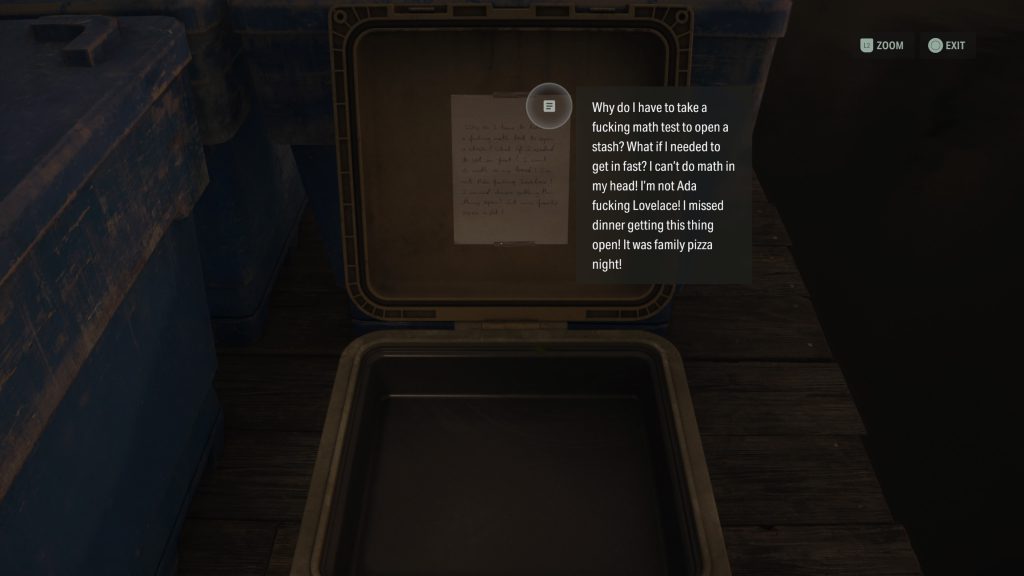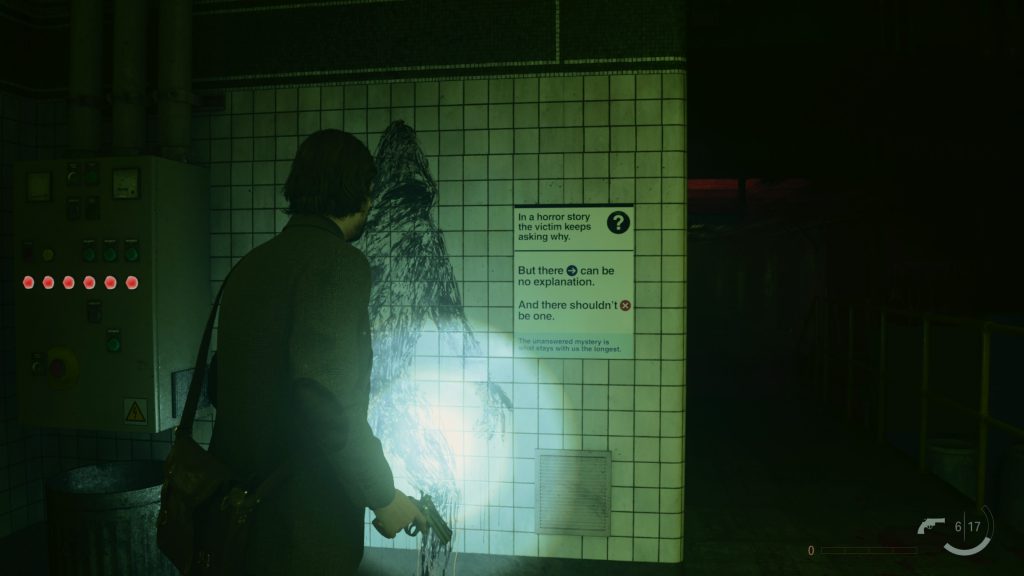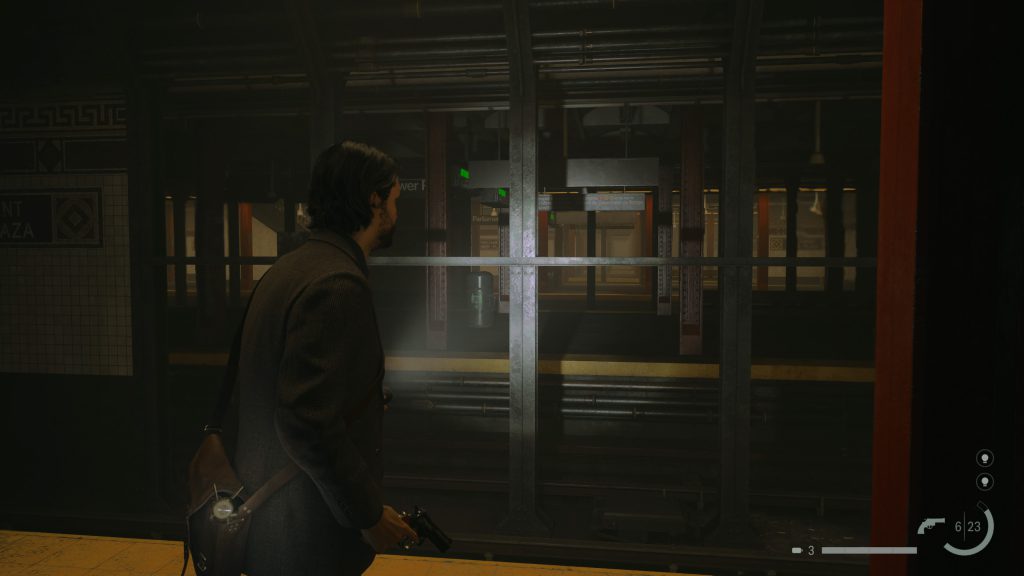THIS REVIEW CONTAINS COMPREHENSIVE STORY SPOILERS FOR ALAN WAKE 2.
To get this out of the way up front: I didn’t really like the musical number.
Alan Wake 2 is the long-anticipated sequel to a game that was frankly kind of mid in its time; 2010’s Alan Wake came as something of a hopeful rebrand that became a downturn and reshuffle for Remedy Entertainment, as they partnered with Microsoft as a publisher for the first time and really tried to make that game work as a single-player experience with strong DLC. That DLC was actually a sequel pitch. American Nightmare was very good, but no one wanted the sequel at that point in time. So it goes! Their next collaboration with Microsoft was the Xbox-exclusive Quantum Break, which statistically very few if any of you reading have played. That’s the first appearance of both the man who would become Tim Breaker and, more importantly, the woman who would not become Saga Anderson. And Quantum Break is only the second-biggest game that Remedy didn’t have the rights to adapt for this title!

Alan Wake 2 is my game of the year; we’re close enough to the end now to publish that, and I don’t think the Ubisoft open-world Avatar franchise title is going to prove me a liar. It is an upgrade to and an evolution of its previous incarnation; it understands that, and it also understands the ways in which trying to surpass itself would screw the entire pooch. For instance, Alan Wake opens Alan Wake by narrating the literal words: “Stephen King once wrote.” Go look it up; as the camera is swooping towards that stupid lighthouse (which is in this game, one way or the other) the Stephen King ripoff is directly quoting Stephen King to tell you how much he’s like Stephen King. That was bad. It was real bad. This time they learned from that experience and just made Alan a delusional mass market post-millennium airport novel gleeman whose new normal lands somewhere around James Patterson, but with stronger character notes. It works so much better.
The star of the show is Saga Anderson — the new Saga Anderson, played by Melanie Liburd. It’s an inspired casting decision in a bottle; she’s a biracial woman who clearly should be startled, and is, when two 67-year-old white retirement home bikers from the Pacific Northwest who rock leather and play Norse-themed black metal and hobnob with the local slumlord and basically do everything you can possibly do in the state of Washington to signal you’re a white supremacist say you’re their granddaughter. This tension is one of the stronger moments in the game, and it’s all the stronger for how hard it is to tell how much of it is diegetically intentional. Old Finnish men named Tor and Odin having a problem with Odin’s daughter marrying a black man, and then apologizing for it without acknowledging his race at all, merely that he was a “troublemaker,” is far more grounding and arresting than whatever’s going with Alan’s book shit. That the game manages to come out the other side of this decision not only intact but kind of touching is a testament to the writing and the confidence in the decision they made to change Saga’s background. It’s very well done.
In fairness to it, though, there’s also a lot going on with Alan’s book shit! The game follows Saga and Alan on parallel, such that Saga has a mind palace (the Mind Place) that she does pin-and-twine poster board stuff on to firm up the direction of the plot in her mind, and Alan has a more Final Draft-esque writer’s easel where he gets to switch out scene directions for all the dumb stuff that’s happening around him all the time. Saga is in the “real world”-coded side of the game while Alan is in the “dream world,” and in this sense this is the best Silent Hill survival horror title in years, because on both sides of the game the world changes into the Correct World and the Other World, based on the valance of the power of light.

Alan Wake 2 is a top-tier survival horror game if you play it on the intended Normal difficulty, and you should. You can play it on Easy and it’s still fun; I switched down to Easy by the end of my time with the title and it’s worth noting specifically why. It wasn’t because of the damage enemies took or how hard the bosses were — the hardest boss in the game is the first one beyond the witch’s cleft down by Cauldron Lake, and you’ll have to defeat him no matter what. It was because of the resource economy that came with playing the game on the intended difficulty. I was working towards a deadline (yes, I know, ha ha ha) and I wanted to get to the end of the title before Christmas without engaging in the resource management that makes up the tension of most of the game. Survival horror has always understood this: you don’t create tension or action or trauma by increasing the damage number that a monster does to your character. Damage happens after the moment of frisson. You increase that tension, action, and trauma by either restricting the ability of the player to stop that damage number — whatever it is! — from being applied or by making it consequential after it’s arrived on the health bar.
So that means that if you’re playing on Normal, you’re going to have to hustle. Every time you want to go somewhere, you’re going to open the map that you have regarding that place, and you’re going to assess what it describes, and in your mind you’re going to decide where the inflection points are and what it will mean if you run into someone you don’t expect on the way. You’re going to decide what you’re going to do that someone you don’t expect, and what the cost will be. A lot of times for Saga it’ll be wolves and for Alan it’ll be normal shadows, but about 30% of the time, it’ll be something worse, and you’re gonna have to hustle. So you’ll have to decide what ammo you want to spend, what distance you want to engage from, and what level of resistance will force you back to your last staging area. Your resources aren’t infinite or even proper. You need to construct an ideology for how to behave.

This is the best way to do survival horror when the controls are good. It was very easy to do survival horror back when the controls could be bad and you didn’t have to think about game feel too much; even today, there are freaks out there who will rush to defend Resident Evil Code Veronica, and insist the problem with that game was Steve. The problem with that game wasn’t Steve; Steve was the guy they put in the game to distract you from all the other stuff you should have complained about and have now converted to nostalgia. If Capcom actually does remake Code Veronica, I hope they do right by Steve. That doesn’t mean making him cool; Steve would be a fantastic authentically-realized dork.
Everyone in Alan Wake 2 is an authentically-realized dork. Saga is one; “Alex Casey” (nee Max Payne, played by Sam Lake and voiced by James McCaffery) is one; Sheriff Tim Breaker from Quantum Leap is one; Agent Kirstan Estevez from the Federal Bureau of Control is one; and Alan Wake is two or three. One of the best things about Alan Wake 2 is that someone realized along the way that Alan is a bad writer. A bad writer isn’t great if you’re reading their novel, sure, but in another piece of media? A bad writer is a very useful thing. Especially if the bad things he writes get instantiated in the world. Frankly, as someone who found the “Alan writes” portions of the first game a slog, I enjoyed his punchier, grimmer prose this time. They give a couple excuses for it in the text, the most prominent being Alan’s editor and doppelganger Scratch (you see, he scratches out the typewriter lines and writes in the replacements, right?) and combined with the incredible environmental design in Alan’s levels it really lets him off the hook for a lot of the more annoying parts of his character.

Saga is, for her own part, fantastic. This is a spoiler review but I don’t actually want to spoil much of Saga’s story, except to say you get to slog through a bunch of soaked 70s and 80s Americana spots in her story that turn out to be terrifying after dark. There’s a thin slice of people who know how uncomfortable “the Enchanted Forest shopping center theme park but based on coffee mascots, at 11 PM with the power out” actually is until they wander into that part of the FBI’s investigation into the cult murders in Bright Falls. My biggest problem with her story is that the game sets up so much interesting stuff about who she is, what she does, and how she does it, and they pays it off much later than it should — to be direct about one facet, Saga’s mind place eventually gets corrupted by the Dark Presence and her string and tack board starts fucking with her in a way that she has to rebel against to escape. This is the entire build and purpose of the whole mechanic in the game, the payoff of its entire purpose…and it happens after one huge story segment and before another segment, making it a cooldown moment for the player instead of a tension builder. I hated that placement of what was objectively an extremely cool bit of storytelling; I thought it was just in the wrong place.
On the other hand, it’s very funny that when Alan Wake finally emerges into the real world under his own power with a gun he can feel in one hand and a flashlight in the other, just in that real protagonist configuration, he actually says out loud something to the effect of, “I’m finally awake.” Hit the fucking title card there, man!
I think a lot about single player games. That’s all I do now, sometimes; I’m very mad Arkane Studios’ Redfall was so much a piece of shit, ideologically and craft-wise, that it wasn’t worth a review on this website. Alan Wake 2 is the best single player game I’ve played since…I can’t talk in extremes, so let’s talk in categories. Games Alan Wake 2 hangs with as a single player experience communicating a vibe: Elden Ring, Immortality, Cyberpunk 2077 (I’m not telling you it’s a massive open world game, please be mature and think of the main plot). Games Alan Wake 2 surpasses: The Last of Us Part II, Resident Evil Village, The Medium (duh but I had to list it), Star Wars: Jedi Survivor, Starfield. And I liked Star Wars: Jedi Survivor!

The game it’s most in conversation with is a game I didn’t put on either list above: Resident Evil 4, remake included. It learns all the lessons it should from that title about controls, spacing, and inventory control, and then puts more stringent weapon design, ammunition, and camera/movement restrictions on the package. At the end of my time with the Normal difficulty of Alan Wake 2 I felt like I was playing Silent Hill 2 with Resident Evil 4 controls. That’s an extreme compliment. It is a very, very good survival horror game, and it has a lot of exploration perks for you to try to strive for off the beaten path to incentivize the survival part of the horror further.
Alan Wake 2 is made for DLC, but it still tells a complete story. That’s something you usually write when a game doesn’t actually tell a complete story but does a Marvel teaser at the end. No, this one tells a complete story, and while it has a Marvel teaser it’s to actually set up the sequel — because the DLC set up is all sideways from the main plot about Alan. David Harewood is fantastic as Warlin Door, and he was featured prominently on the Game Awards presentation of the game’s live musical number. He really earns his screen time in Alan Wake 2, but there’s no pay off for him in the normal playthrough of the base game. He’s the sort of guy the title’s DLC will be based around, not Alan himself, who is busy with other stuff. This is part of the franchise where the whole interconnected IP stuff shines — not just because people kind of want the Director of the Board of the Federal Bureau of Control to actually show up one of these days in Alan Wake 2, but because she doesn’t need to for a fight between Alan or Tim and Warlin to matter in the grand scheme of things. A $20 dollar DLC for a game you like can actually be much more narratively impactful than an off-year Ant-man movie.

The Alan Wake 2 Checklist: Do you really like Stephen King? Skip down the list. Do you like making fun of Stephen King? This is for you. Do you like Twin Peaks? This is for you. Do you like Silent Hill? This is for you. Do you like feeling bad and creeped out in places with too much rainfall? This is for you. Do you like dream fugue states? This is for you. Do you like quaint stories about Finns? This is for you. Do you like Ahti? This is for you. Do you like the way it feels when you notice just before the story tells you that something is terribly wrong? This is for you. Do you like saying to yourself, “it’s not a loop, it’s a spiral?” This is for you. Do you like saying to yourself, “it’s not a spiral, it’s a ladder?” This is for you. Do you like pointing at inverted triangles on your screen and chuckling because you think you know what they mean? This is for you. Do you like then relearning what triangles mean in this game? This is for you.
Max Payne is still the best game this company ever made because of course it was. The history behind that game, which shines through in this one, is just something else. “Oh, they couldn’t get the license back from Rockstar, who they sold it to twenty years ago.” That’s true. But in Alan Wake 2 there’s a dream-like sequence where you observe the number of the Neighbor of the Beast, then emerge into “Caldera Street Station,” and follow an improbably-long trail of blood through a subway as a tweaked-out gang of villains uses a V symbol to intimidate you as they kill a bunch of cops. And somewhere in there, Sam Lake in full Max Payne get-up gets executed in front of you, in his stupid tie. It would actually kind of be overkill if they didn’t have to call him “Alex Casey” instead of his obvious actual name.
But Max Payne 2 was unremarkably better than the original — basically just an expansion pack with new maps and a new story (and no Sam Lake in the fumetti). Alan Wake 2 is a sea-change improvement. It makes hopes for both the eventual sequel to Control and the Max Payne remakes that Remedy is overseeing much higher than they would have been, and fair or not, that’s really good for business. It’s the best game of the year, to me.
And like, I didn’t really care for the musical number. It’s still Game of the Year.
Have any questions or feedback? Want to make a case for some other game as Game of the Year? Drop us a note in the comments below or email us at contact@goonhammer.com.



You must be logged in to post a comment.